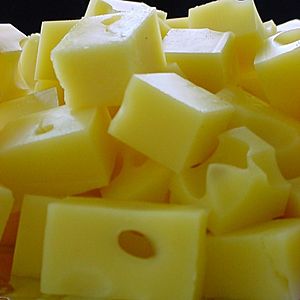Swiss cheese (North America) facts for kids
Quick facts for kids Swiss cheese |
|
|---|---|

Cubes of Swiss cheese
|
|
| Source of milk | Cows milk |
| Named after | Lua error in Module:Wikidata at line 70: attempt to index field 'wikibase' (a nil value). |
Swiss cheese is a type of cheese that looks a lot like Emmental cheese. Emmental is a yellow, medium-hard cheese that first came from the Emmental area in Switzerland. Swiss cheese is known as a Swiss-type or Alpine cheese.
Some kinds of Swiss cheese have a special look. They have holes called "eyes" all over them. If Swiss cheese does not have these holes, it is called "blind."
Today, Swiss cheese is made in many places. This includes countries like the United States, Finland, Estonia, and Ireland. Sometimes, it is made with pasteurized or part-skim milk. The original Swiss cheese from Switzerland uses raw milk. In the United States, "Swiss cheese" and "Emmentaler cheese" often mean the same thing.
How Swiss Cheese Is Made
Making Swiss cheese involves three types of tiny living things called bacteria. These are Streptococcus thermophilus, Lactobacillus, and Propionibacterium.
During the last part of making the cheese, the Propionibacterium bacteria get to work. They eat something called lactic acid that the other bacteria made. When they do this, they let out different things. These include acetate, propionic acid, and carbon dioxide gas.
The carbon dioxide gas slowly forms bubbles. These bubbles are what become the famous "eyes" in the cheese. The acetate and propionic acid give Swiss cheese its special nutty and sweet taste.
In 2015, some Swiss scientists suggested something new. They thought that tiny bits of stuff in the milk might help make the holes. They believed that modern, super-clean ways of making cheese removed things like hay dust. This might be why the holes in Swiss cheeses became smaller, or why some cheese became "blind." A long time ago, people thought holes were a mistake. Cheese makers even tried to stop them from forming. But now, the holes are a key part of what makes Swiss cheese special!
Generally, bigger holes in Swiss cheese mean a stronger taste. This is because a longer fermentation time lets the bacteria work more. However, cheese with very large holes can be hard to slice. It might break apart in slicing machines. Because of this, rules in the U.S. have set a smaller minimum size for the holes. This helps the cheese get a top quality stamp.
Types of Swiss Cheese
Two popular kinds of American Swiss cheeses are Baby Swiss and Lacy Swiss. Both of these cheeses have small holes and a mild taste. Baby Swiss is made from whole milk. Lacy Swiss is made from milk with less fat.
Baby Swiss was first made in the mid-1960s. It was created by the Guggisberg Cheese Company. This company is located near Charm, Ohio.
What's Inside Swiss Cheese?
| Water | Protein | Fat | Carbs | |
|---|---|---|---|---|
| Swiss | 37.1 | 26.9 | 27.8 | 5.4 |
| Feta | 55.2 | 14.2 | 21.3 | 4.1 |
| Cheddar | 36.8 | 24.9 | 33.1 | 1.3 |
| Mozzarella | 50 | 22.2 | 22.4 | 2.2 |
| Cottage | 80 | 11.1 | 4.3 | 3.4 |
| A | B1 | B2 | B3 | B5 | B6 | B9 | B12 | C | D | E | K | |
|---|---|---|---|---|---|---|---|---|---|---|---|---|
| Swiss | 17 | 4 | 17 | 0 | 4 | 4 | 1 | 56 | 0 | 11 | 2 | 3 |
| Feta | 8 | 10 | 50 | 5 | 10 | 21 | 8 | 28 | 0 | 0 | 1 | 2 |
| Cheddar | 20 | 2 | 22 | 0 | 4 | 4 | 5 | 14 | 0 | 3 | 1 | 3 |
| Mozzarella | 14 | 2 | 17 | 1 | 1 | 2 | 2 | 38 | 0 | 0 | 1 | 3 |
| Cottage | 3 | 2 | 10 | 0 | 6 | 2 | 3 | 7 | 0 | 0 | 0 | 0 |
| Cl | Ca | Fe | Mg | P | K | Na | Zn | Cu | Mn | Se | |
|---|---|---|---|---|---|---|---|---|---|---|---|
| Swiss | 2.8 | 79 | 10 | 1 | 57 | 2 | 8 | 29 | 2 | 0 | 26 |
| Feta | 2.2 | 49 | 4 | 5 | 34 | 2 | 46 | 19 | 2 | 1 | 21 |
| Cheddar | 3 | 72 | 4 | 7 | 51 | 3 | 26 | 21 | 2 | 1 | 20 |
| Mozzarella | 2.8 | 51 | 2 | 5 | 35 | 2 | 26 | 19 | 1 | 1 | 24 |
| Cottage | 3.3 | 8 | 0 | 2 | 16 | 3 | 15 | 3 | 1 | 0 | 14 |
Nutrient data from SELF.com. Abbreviations: Cl = Choline; Ca = Calcium; Fe = Iron; Mg = Magnesium; P = Phosphorus; K = Potassium; Na = Sodium; Zn = Zinc; Cu = Copper; Mn = Manganese; Se = Selenium.

